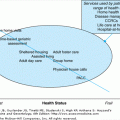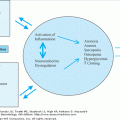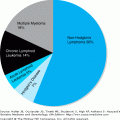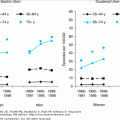Complementary and Alternative Medicine: Introduction
Complementary and alternative medicine (CAM) modalities constitute a diverse group of consumer-driven medical and health care practices outside the realm of conventional medicine, which are yet to be validated using scientific methods. Considered as such, CAM practices are ever changing. Most CAM use is complementary, that is, as an adjunct to conventional practices, and only a minority is used as an alternative to mainstream medical care. A main tenet of CAM therapy is that it stimulates and strengthens the body’s own natural defense systems to prevent and treat diseases. Thus, elderly as well as nonelderly individuals use CAM practices with the hope of improving wellness and for relief of symptoms attributable to chronic, “stressful,” degenerative, or fatal conditions.
From a conceptual perspective, the panoply of CAM modalities can be divided into five major groupings: alternative medical systems, mind–body interventions, manipulative and body-based methods, energy therapies, and biologically based treatments (including dietary supplements) (Table 25-1). A dietary supplement is defined as: (1) a product that contains one or more of the following ingredients: vitamin, mineral, herb, botanical, amino acid, or a substance to increase total daily intake; (2) ingested orally; (3) not a conventional food or sold as a meal or diet, and (4) labeled as a dietary supplement (Food and Drug Administration (FDA) Web site).
Alternative medical systems | Complete systems that evolved independent of and often prior to conventional medicine, e.g., traditional systems
|
Mind–body interventions | Application of techniques designed to facilitate the mind’s ability to affect one’s body symptoms and functions.
|
Biologically based treatments | Natural and biologically based practices, interventions, and products
|
Manipulative and body-based methods | Modalities based upon manipulation and/or movement of the body
|
Energy therapies | Focus on energy fields believed to originate within the body or from other sources
|
In the United States, CAM practices are widely available (Table 25-2), but are largely unregulated. Among CAM practices, only five (acupuncture, chiropractic, massage, naturopathy, and homeopathy) are licensed in multiple states, whereas several others (art therapy, traditional Chinese medicine, reflexology) are licensed in only a few states, and still others (biofeedback, hypnosis) require only certification. Moreover, the scope of practice may vary from state to state (e.g., acupuncture). The American public spends more out-of-pocket for CAM practices than for all other health care needs. Most consumers believe that their health plans should pay for CAM treatments, and an increasing number of insurers and Health Maintenance Organizations are now doing so.
|
The reasons for CAM use are multiple, but include dissatisfaction with conventional medicine because of its ineffectiveness in producing cures, cost, adverse effects, and depersonalization. CAM use also empowers the individual to take control over personal health decisions, and focuses on the individual’s values, spiritual and religious philosophy, and beliefs regarding the nature and origins of illness. The fragmentation of care by busy specialists, and provision by CAM therapists of “touch, talk, and time,” as well as media reports of dramatic results, all contribute to the increasing interest in CAM therapies.
Current Use and Concerns with CAM Modalities
In recent years, the use of CAM has steadily increased among adults of all ages. In the largest U.S. study to date, nearly 29% of 30 801 respondents to a 1999 National Health Interview Survey reported using at least one CAM modality in the prior year (Barnes, et al., 2004). This prevalence of CAM usage is somewhat less than that reported in other surveys. According to Eisenberg’s (1998) follow-up of his earlier national survey, the probability of an adult American visiting a CAM provider increased by 30% during the 1990s, to 46.3% in 1997, accounting for approximately $27 billion in out-of-pocket expenses. It was estimated that nearly 60% of CAM use was not disclosed to health care providers. Alternative therapies were most frequently pursued for chronic conditions including back problems, anxiety, depression, and headaches. The therapies of escalating usage included botanicals, massage, vitamins, self-help group, folk remedies, energy healing, and homeopathy.
The use of dietary supplements in older adults is substantial. The Slone Survey reported that 40% of U.S. older adults take at least one vitamin/mineral and one in seven older adults take at least one herbal supplement (Kaufman, et al., 2002). A study using data from the 2002 National Health Interview reported that 12.9% of the elderly reported the use of a herbal product in previous 12 months (Bruno, et al., 2005). The most common products used included glucosamine/condroitin, saw palmetto, ginkgo, and St. John’s Wort.
The use of dietary supplements is of concern because the manufacturers are not responsible for proving efficacy or safety for these products before marketing (Anon, 2002). The FDA has however recommended that manufacturers stop selling several products due to concerns about toxicity (e.g., kava, ephedrine). They have also cautioned about drug interactions with St. John’s Wort, a potent inducer of certain hepatic cytochrome P450 isoenzymes (Xie and Kim, 2005). Table 25-3 lists clinically important drug interaction with St John’s Wort and other dietary supplements with prescription medications (especially narrow therapeutic range drugs) and their impact on patient outcomes (Xie and Kim, 2005; Holbrook, et al., 2005; Williamson, 2003; Tyagi, et al., 2003).
OBJECT DRUG | INTERACTING HERB | OUTCOME |
|---|---|---|
Antidepressants | St. John’s Wort | Serotonergic syndrome |
Anticonvulsants | Shankpushpi | ↓ Seizure threshold |
Anticonvulsants | Wormwood | ↓ Seizure threshold |
Anticonvulsants | Gingko biloba | ↓ Seizure threshold |
Cyclosporine | St John’s Wort | Transplant rejection |
Digoxin | Hawthorn | ↑ Digoxin activity |
Digoxin | Siberian ginseng | ↑ Digoxin levels |
Digoxin | St John’s Wort | ↓ Digoxin levels |
Indinavir | St John’s Wort | ↓ Indinavir levels |
Theophylline | St John’s Wort | ↓ Theophylline levels |
Warfarin | Gingko biloba | ↑ Risk of bleeding |
Warfarin | Dong quai | ↑ Risk of bleeding |
Warfarin | St. John’s Wort | ↓ Warfarin activity |
Warfarin | Ginseng | ↓ Warfarin activity |
Recently, new FDA regulations have been passed regarding dietary supplements. As of December 2007, manufacturers will now be required to report serious adverse events to the FDA (Morrow, 2008). Moreover, starting June 2008, a new FDA rule will be implemented entitled “Current Good Manufacturing Practice in Manufacturing, Packaging, Labeling, or Holding Operations for Dietary Supplements.” Essentially what this rule does is assure that what is on the label of a dietary supplement is what is contained in the product itself (Morrow, 2008).
Use of CAM Modalities for Disorders of the Elderly Patient
While CAM modalities may be used for a number of conditions experienced by the elderly, evidence-based data supporting their use is limited. We describe in the following sections what is known for six common conditions, depression, anxiety, insomnia, osteoarthritis, dementia, and benign prostatic hypertrophy.
Of the domains of CAM listed on Table 25-1
Stay updated, free articles. Join our Telegram channel

Full access? Get Clinical Tree







